
The Uxbridge Common District is located in downtown Uxbridge, Massachusetts. It is listed on the National Register of Historic Places. Historic buildings in this district include the Uxbridge Academy, Uxbridge Free Public Library, the Deborah A. Wheelock House, a blacksmith shop, the First Congregational Church, and the Unitarian Church.

The Israel B. Mason House is an historic house at 571 Broad Street in Providence, Rhode Island. It is a 2+1⁄2-story wood-frame structure, built in 1888 for Israel Bowen Mason, a wealthy merchant. It is one of the city's finest Queen Anne residences, with a visually complex assortment of projecting bays, verandas, turrets and gables. Particularly of note are its eastern porch and three-story octagonal tower. The house was designed by Alfred E. Stone, a prominent local architect, for Mason, a self-made successful wholesaler of grocery and meat products. The house now houses a funeral home.
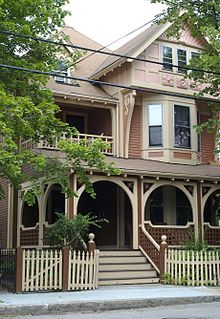
The Edmund Reardon House is a historic house in Cambridge, Massachusetts. The 2.5-story Queen Anne house was built in 1884 for Edmund Reardon, whose family operated a nearby soap factory. The house has elaborately decorated porches and half-timbering in various gable ends.
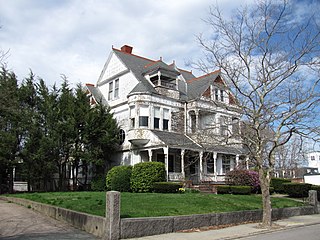
The Dr. Edgar Everett Dean House is a historic house located at 81 Green Street in Brockton, Massachusetts.

The Old Post Office Building is a historic building in Brockton, Massachusetts. The two story brick Colonial Revival-style post office was built in 1898 and expanded in 1932. It was designed under the auspices of the federal government's supervising architect, James Knox Taylor, as a copy of Independence Hall in Philadelphia. The building was renovated in 1977 and became home of the Brockton Public Schools central administration offices.
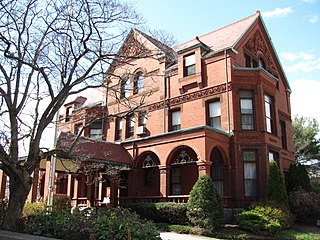
The Gardner J. Kingman House is a historic house located at 309 Main Street in Brockton, Massachusetts.

The Simmons Block is a historic commercial building in Adams, Massachusetts. Built about 1885, it is one of town's most elaborate examples of Queen Anne Victorian architecture. It was listed on the National Register of Historic Places in 1982.
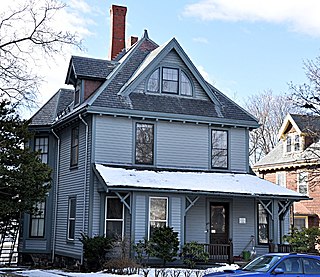
The Walter S. and Melissa E. Barnes House is a historic house at 140 Highland Avenue in Somerville, Massachusetts. Built about 1890, it is one of the city's least-altered examples of Queen/Stick style Victorian architecture. It was for many years home to Robert Luce, a one-term Lieutenant Governor of Massachusetts. It was listed on the National Register of Historic Places in 1990.
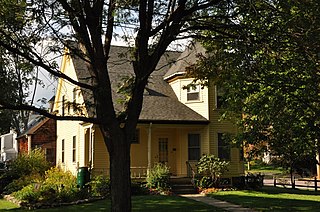
The Charles Wells House is a historic house in Reading, Massachusetts. The two-story Queen Anne Victorian wood-frame house was built in 1894 by Charles Wells, a New Brunswick blacksmith who married a Reading woman. The house is clad in clapboards and has a gable roof, and features a turret with an ornamented copper finial and a front porch supported by turned posts, with a turned balustrade between. A small triangular dormer gives visual interest to the roof above the porch. The house is locally distinctive as a surviving example of a modest Queen Anne house, complete with a period carriage house/barn.

The Walter Keene House is a historic house at 28 High Street in Stoneham, Massachusetts. The 2+1⁄2-story wood-frame building was built c. 1900, and is an excellent local example of a transitional Queen Anne-Colonial Revival house. Its hip roof and front porch are typically Colonial Revival, while the left-side turret and turned posts and balusters are Queen Anne. The house was built Walter Keene, a local shoe salesman and banker who was responsible for developing much of the surrounding area. Stoneham's Keene Street is named for him.
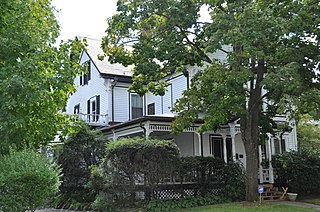
The Henry N. Fisher House is a historic house at 120 Crescent Street in Waltham, Massachusetts. It is a 2+1⁄2-story wood-frame structure, with the asymmetrical massing typical of Queen Anne houses. It has a wraparound porch with turned posts, lattice railing, and a sunburst motif in the gabled pediment above the steps. The interior has well-preserved woodwork and marble fireplaces. The house was built c. 1881–86, and is a well-preserved Queen Anne Victorian on the city's south side. It was home for many years to Henry N. Fisher, who served as city mayor in the late 1880s, and was a foreman at the Waltham Watch Company.

25 Avon Street is a historic house, and is significant as one of the more elaborate Queen Anne Victorian houses in the town of Wakefield, Massachusetts.

The House at 39 Converse Street in Wakefield, Massachusetts, United States, is a well-preserved Queen Anne Victorian house. It was built c. 1880 as part of a real estate development along Converse Street. It is a 2+1⁄2-story wood-frame structure, with a hip roof and cross gable. It features decorative shingle bands in sections on the second floor, and between the first and second floors. The L-shaped house has a second story projecting gabled section over a rounded projecting bay on the first floor.

The House at 15 Lawrence Street in Wakefield, Massachusetts is a well-preserved Queen Anne house with a locally rare surviving carriage house. It was built in the early 1870s, and was listed on the National Register of Historic Places in 1989.

The House at 556 Lowell Street in Wakefield, Massachusetts is a high style Queen Anne Victorian in the Montrose section of town. The 2+1⁄2-story wood-frame house was built in 1894, probably for Denis Lyons, a Boston wine merchant. The house is asymmetrically massed, with a three-story turret topped by an eight-sided dome roof on the left side, and a single-story porch that wraps partially onto the right side, with a small gable over the stairs to the front door. That porch and a small second-story porch above are both decorated with Stick style woodwork. There is additional decoration, more in a Colonial Revival style, in main front gable and on the turret.
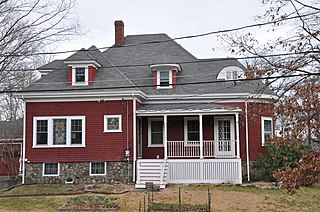
The House at 2 Nichols Street in Wakefield, Massachusetts, is a well-preserved, architecturally eclectic house built in the 1890s. The 1+1⁄2-story frame house has elements of the Tudor Revival, Queen Anne, and Shingle styles, and is one of two identical houses built by local builder Berndt Heurlin. It has a hip roof, but transverse gables, one of which has a rounded bay, giving it a Queen Anne feel. The foundation exterior is fieldstone, and there are several stained glass windows.

The Dr. Charles Jordan House is a historic house at 9 Jordan Avenue in Wakefield, Massachusetts. Built c. 1885, it is one Wakefield's most elaborate Queen Anne Victorian houses. The 2+1⁄2-story wood-frame house is unusual for having a hipped roof; it also has a tower in the northwest corner, and a porch with Italianate pillars brackets. The house was built by Dr. Charles Jordan, a local physician and pharmacist with extensive land holdings in the area.

Wakefield Park Historic District is a residential historic district encompassing a portion of a late-19th/early-20th century planned development in western Wakefield, Massachusetts. The district encompasses sixteen properties on 8 acres (3.2 ha) of land out of the approximately 100 acres (40 ha) that comprised the original development. Most of the properties in the district are on Park Avenue, with a few located on immediately adjacent streets.

The Foster-Redington House is a historic house at 8 Park Place in Waterville, Maine. Built in 1883, it is a fine example of Queen Anne architecture, supposedly the city's first example of the style. It was built by Moses Coburn Foster, a well-known builder in the state, as his private residence. Moses owned M.C. Foster & Son, general contractors and builders. An advertisement for the business lists its location as 7 Park Place, which was the home built for his son, Herbert Foster. Herbert died at 38 years old. Herbert's home is as unique as Moses' but has not been restored, but instead, turned into two apartments.
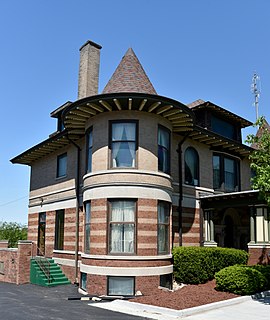
The Crawford House is a historic building located in Des Moines, Iowa, United States. R.A. Crawford was a local banker who hired the Des Moines architectural firm of Liebbe, Nourse & Rasmussen to design this house, which was completed in 1896. It is located in a section of the city that contains other large residences that calls attention to the city's economic expansion. The 2½-story, brick structure is a combination of the Queen Anne and the Neoclassical styles. It features alternating colors of brick, limestone stringcourses, and two round towers with conical roofs that flank the main facade. The single-family home was converted into a funeral home in 1945. The house was listed on the National Register of Historic Places in 1983.























